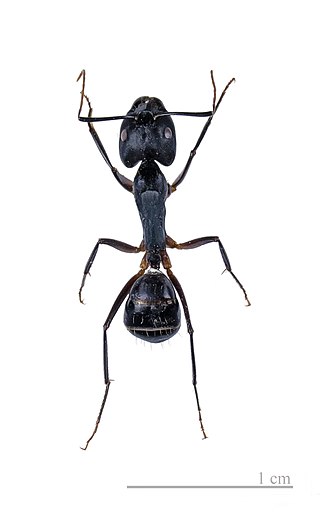
The Formicinae are a subfamily within the Formicidae containing ants of moderate evolutionary development.
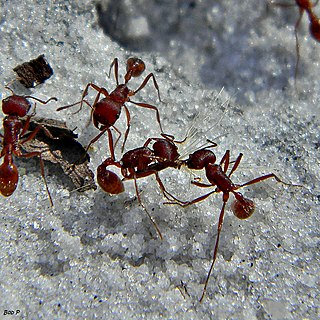
Harvester ant, also known as harvesting ant, is a common name for any of the species or genera of ants that collect seeds, or mushrooms as in the case of Euprenolepis procera, which are stored in the nest in communal chambers called granaries. They are also referred to as agricultural ants. Seed harvesting by some desert ants is an adaptation to the lack of typical ant resources such as prey or honeydew from hemipterans. Harvester ants increase seed dispersal and protection, and provide nutrients that increase seedling survival of the desert plants. In addition, ants provide soil aeration through the creation of galleries and chambers, mix deep and upper layers of soil, and incorporate organic refuse into the soil.

Paratrechina is one of seven ant genera in the Prenolepis genus-group from the subfamily Formicinae. Six species are included in Paratrechina; one of which, the longhorn crazy ant, is a widespread, pantropical pest.
Euprenolepis echinata is a Southeast Asian species of ant in the subfamily Formicinae.
Euprenolepis maschwitzi is a Southeast Asian species of ant in the subfamily Formicinae.
Euprenolepis thrix is a Southeast Asian species of ant in the subfamily Formicinae.
Euprenolepis variegata is a Southeast Asian species of ant in the subfamily Formicinae.
Euprenolepis zeta is a Southeast Asian species of ant in the subfamily Formicinae.
Euprenolepis wittei is a Southeast Asian species of ant in the subfamily Formicinae.

Euprenolepis procera is a species of ant found in the rainforests of South East Asia. It was first described by Carlo Emery, an Italian entomologist, in 1900. In 2008, Witte & Maschwitz discovered that E. procera specialises in harvesting mushrooms in the rainforest for food, representing a new, previously unreported feeding strategy in ants.

Eutetramorium is a small genus of ants within the subfamily Myrmicinae. To date it contains three species found in Madagascar and Comoros.

Nylanderia is a large genus of ants in the subfamily Formicinae. The genus has a nearly cosmopolitan distribution with species inhabiting a wide array of habitats in almost all geographic regions. Nylanderia, currently containing over 110 species, is an ecologically important genus, with some species reported as being invasive. The ants are small to medium in size and range in color from pale yellow to black.

Paraparatrechina is a genus of small ants in the subfamily Formicinae. The genus contains 31 species distributed in the tropics of Africa, Asia and Australia.

Pseudolasius is a genus of ants in the subfamily Formicinae. The genus is known from southern Asia to northern Australia, where it appears to be restricted to tropical areas. These ants are commonly known as twig ants due to their habit of nesting in twigs or hollow stems.
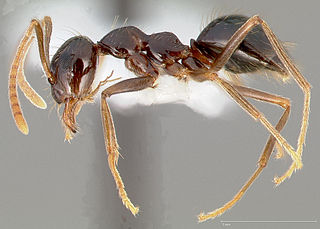
Prenolepis is a genus of ants in the subfamily Formicinae. Most species are found in southeastern Asia and southern China, but the genus has a wide distribution with species known from North America, southern Europe, Anatolia, Cuba, Haiti, and West Africa.

Adetomyrma caudapinniger is a species of ant endemic to Madagascar.
Euprenolepis negrosensis is an ant species that belongs to the genus Euprenolepis. Described by Wheeler in 1930, they are normally found in South East Asia.
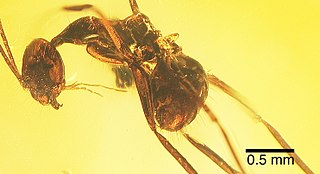
Zatania electra is an extinct species of ant in the subfamily Formicinae known from three possibly Miocene fossils found on Hispaniola. Z. electra is one of several Zatania species found in the Greater Antilles.

Nylanderia pygmaea is an extinct species of formicid in the ant subfamily Formicinae known from fossils found in the Baltic region.
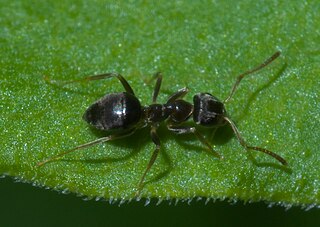
Lasiini is a tribe of ants in the family Formicidae. There are about 10 genera and more than 450 described species in Lasiini.













